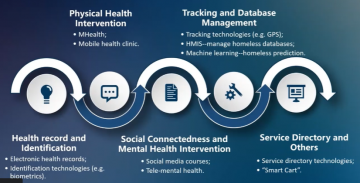…..
Our Mission
The goal of our study is to explore how support from public service sectors can help people experiencing homelessness (PEH) obtain social inclusion through obtaining digital inclusion.
Project Overview

Digital technology has become ubiquitous in society, and radically transformed the way we communicate, work and conduct our friendships and relationships. Social media such as Facebook is used to contact our loved ones, e-banking is used to transfer and pay bills, e-health is used for diagnosing and appointment reminders, and the Internet provides us with tons of information every day about new job opportunities and education.
Different than most of our impressions, previous research shows that most people experiencing homelessness own mobile phones (Post et al., 2013; Rhoades et al., 2017). However, they cannot take full advantage of the convenience brought by digital technology because of the challenges they are facing including charging the batteries of their digital devices and getting stable Internet access. Many studies show that PEH is reliant on public service sectors such as public libraries, social service agencies, and churches to access computers, the Internet, and other digital technology, and acquire knowledge and skill training for using digital technology (Eyrich-Garg, 2011; Marler, 2021). Therefore, public service sectors can act as mediums to provide social support (including instrumental support that provides PEH with computers, Internet, and charging spots access; emotional support that provides appraisal or social companionship when PEH have fear or anxiety using technology; and informational support that provides digital skill training and guidance) to help PEH bridge the digital inequity, and thus benefit them contacting loved ones, getting equal health and social services, finding housing, getting equal opportunities of educations and jobs, and obtaining social inclusion.
Our research team is part of the Kelowna Homelessness Research Collaborative (KHRC). The goal of our study is to explore how support from public service sectors can help PEH’s obtain social inclusion through obtaining digital inclusion.
Methodologies
Our study is based on social support theory and unified theory of acceptance and use of technology. Hypotheses are developed after a review of the literature and theory. Survey methodology will be employed to collect data needed, including a survey with people working in public service sectors and a survey with PEH. By surveying both the public service sectors and PEH, and with the help from public service sectors, we hope our study can authentically benefit the social inclusion of those experiencing homelessness. Finally, the partial least square model will be used to analyze the data.
…..

Project Status
We have reviewed the existing literature and theories, and summarized the access, usage, and digital literacy status of PEH. We have already built the theoretical framework and developed seven hypotheses. We have created the measurement scale of each item (including social support measurements, technology access, and usage measurements, digital literacy measurements, and social inclusion measurements). We are now working on surveying people working in public service sectors and forming cooperation’s with them to continue the next step of our survey.
….
Contributions

Theoretically, this research explores the factors affecting the digital and social inclusion of PEH and offers insights on the potential implications of social support from public service sectors for PEH to achieve social inclusion. Practically, this study forms cooperation with public service sectors, examines the effectiveness of obtaining social support from public service sectors on the social inclusion of PEH, and gives advice to the government and public service sectors on what support needs to be improved to help PEH obtain digital and social inclusion.
More information
Project Details
Lead Researcher: Xuege Wang
Research Partner: Kelowna Homelessness Research Collaborative (KHRC)
Funding Partners: Social Sciences and Humanities Research Council of Canada (SSHRC) Partnership Development Grants
Industry Partners: Kelowna Gospel Mission
Working Papers and Presentations
- Xuege Wang, Eric P. H. Li, Gordon Lovegrove, Sarah J. Dow-Fleisner, Kyler Woodmass. How technological innovations support people experiencing homelessness: A Literature Review.
- Xuege Wang. How does support from public service sectors work when people experiencing homelessness obtain social inclusion through obtaining digital inclusion?
- Xuege Wang. Homelessness and Technology. Homelessness research in the Okanagan and beyond, Canada (2021).
Other Resources
References
- Eyrich-Garg, K. M. (2011). Sheltered in cyberspace? Computer use among the unsheltered ‘street’ homeless. Computers in human behavior, 27(1), 296-303. doi:10.1016/j.chb.2010.08.007
- https://lankellychase.org.uk/wp-content/uploads/2015/01/Trends-and-Friends-2015.pdf
- Marler, W. (2021). ‘You can’t talk at the library’: the leisure divide and public internet access for people experiencing homelessness. Information, communication & society, 1-19. doi:10.1080/1369118X.2021.2006742
- Post, L. A., Vaca, F. E., Doran, K. M., Luco, C., Naftilan, M., Dziura, J., . . . D’Onofrio, G. (2013). New media use by patients who are homeless: the potential of mHealth to build connectivity. Journal of Medical Internet Research, 15(9), e195. doi:10.2196/jmir.2724
- Rhoades, H., Wenzel, S. L., Rice, E., Winetrobe, H., & Henwood, B. (2017). No digital divide? Technology use among homeless adults. Journal of Social Distress and Homeless, 26(1), 73-77. doi:10.1080/10530789.2017.1305140